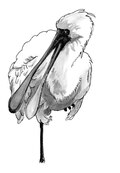Jamaican ibis
| Jamaican ibis Temporal range: Early Holocene
| |
|---|---|
| Scientific classification | |
| Domain: | Eukaryota |
| Kingdom: | Animalia |
| Phylum: | Chordata |
| Class: | Aves |
| Order: | Pelecaniformes |
| Family: | Threskiornithidae |
| Genus: | †Xenicibis Olson & Steadman, 1977 |
| Species: | †X. xympithecus
|
| Binomial name | |
| †Xenicibis xympithecus | |

| |
| Former range (in red) | |
The Jamaican ibis, Jamaican flightless ibis[1] or clubbed-wing ibis[2] (Xenicibis xympithecus) is an extinct bird species of the ibis subfamily uniquely characterized by its club-like wings.[3] It is the only species in the genus Xenicibis,[1] and one of only two flightless ibis genera,[2][3] the other being the genus Apteribis which was endemic to Hawaii's islands of Maui Nui.[2][4]
Description[edit]
The species was first described in 1977 based on postcranial bone elements excavated in a cave deposit at Long Mile Cave, Jamaica, by H. E. Anthony in 1919–20.[1][5] At the time, it was presumed to be flightless based on the incomplete coracoid;[1] its flightlessness was confirmed after a humerus of the same species was found in the Swansea Cave, Jamaica.[5][6] New fossil finds from two locations, including the Red Hills Fissure, show that the bird has a unique modification of the carpometacarpus, rendering it club-like.[3] The metacarpal is enlarged and bowed distally with thickened walls, while the ulna and radius have been modified as well. From its maximum femur diameter of 8.7 mm, it has been estimated that the Jamaican Ibis weighed about 2 kg (70 oz).[3]
Clubbed wing function[edit]
Ornithologists speculate that the wings were used as weapons, in the manner of a club or flail,[3] similar to the adaptations found in some mantis shrimps (Stomatopoda: Gonodactyloidea) that possess a club-like distally inflated dactyl used to strike prey and other shrimps.[7] Among birds, this adaption seems unique.[3] In birds, adaptations of the wing that are advantageous in the context of fighting represent an example of contingency in which species find different solutions to the same problem as a result of random variations.[3][8]

Distribution[edit]
The Jamaican ibis was endemic to Jamaica. Bones have been excavated from several caves, including the Long Mile Cave,[1] the Swansea Cave,[6] the Jackson's Bay Cave[9] and the Red Hills Fissure.[3] Bones from Cuba claimed to be of this genus[10] were later identified as those of a limpkin. Jamaica and Cuba have never been linked, so it is improbable that a flightless species could reach a different island.[5]
References[edit]
- ^ a b c d e Olson, Storrs L; Steadman, David W (1977). "A new genus of flightless ibis (Threskiornithidae) and other fossil birds from cave deposits in Jamaica". Proceedings of the Biological Society of Washington. 90 (2): 447–457.
- ^ a b c Tyrberg, Tommy (2009). "Holocene avian extinctions". In Turvey, Sam (ed.). Holocene Extinctions. Oxford University Press. pp. 63–106. ISBN 978-0-19-953509-5.
- ^ a b c d e f g h Longrich, N. R.; Olson, S. L. (2011). "The bizarre wing of the Jamaican flightless ibis Xenicibis xympithecus: a unique vertebrate adaptation". Proceedings of the Royal Society B: Biological Sciences. 278 (1716): 2333–2337. doi:10.1098/rspb.2010.2117. PMC 3119002. PMID 21208965.
- ^ Olson, Storrs L.; Wetmore, Alexander (1976). "Preliminary diagnoses of two extraordinary new genera of birds from Pleistocene deposits in Hawaiian Islands" (PDF). Proceedings of the Biological Society of Washington. 89: 247–258. Retrieved January 7, 2011.
- ^ a b c Suárez, William (2001) "Deletion of the flightless ibis Xenicibis from the fossil record of Cuba" Archived 2011-10-01 at the Wayback Machine. Caribbean Journal of Science 37 (1–2): 109–110
- ^ a b Olson, Storrs L; Steadman, David W (1979). "The humerus of Xenicibis, the extinct flightless ibis of Jamaica". Proceedings of the Biological Society of Washington. 92: 23–27.
- ^ Patek, S. N.; Korff, W. L.; Caldwell, R. L. (2004). "Biomechanics: Deadly strike mechanism of a mantis shrimp". Nature. 428 (6985): 819–20. Bibcode:2004Natur.428..819P. doi:10.1038/428819a. PMID 15103366. S2CID 263603633.
- ^ Gould, Stephen J (1989). Wonderful Life: The Burgess Shale and the Nature of History. New York: W. W. Norton. pp. 347. ISBN 0-393-02705-8.
- ^ McFarlane, D A; Lundberg, J; Fincham, A G (August 2002). "A late Quaternary paleoecological record from caves of southern Jamaica, West Indies" (PDF). Journal of Cave and Karst Studies. 64 (2): 117–125.
- ^ Arredondo, Oscar (1984). "Sinopsis de las aves halladas en depósitos fosilíferos pleisto-holocénicos de Cuba". Reporte de Investigación del Instituto de Zoología (in Spanish). 17: 1–3.





